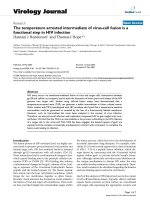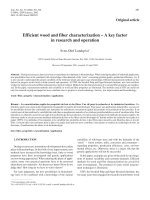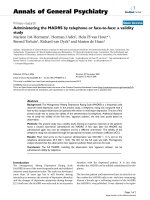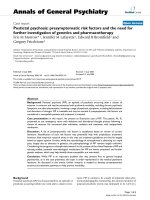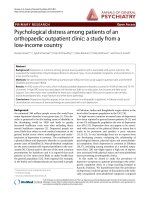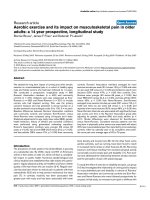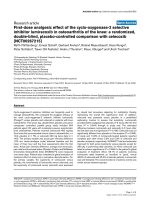Báo cáo y học: " Soy consumption and risk of COPD and respiratory symptoms: a case-control study in Japan" ppsx
Bạn đang xem bản rút gọn của tài liệu. Xem và tải ngay bản đầy đủ của tài liệu tại đây (222.23 KB, 7 trang )
BioMed Central
Page 1 of 7
(page number not for citation purposes)
Respiratory Research
Open Access
Research
Soy consumption and risk of COPD and respiratory symptoms: a
case-control study in Japan
Fumi Hirayama
1
, Andy H Lee*
1
, Colin W Binns
1
, Yun Zhao
1
,
Tetsuo Hiramatsu
2
, Yoshimasa Tanikawa
3
, Koichi Nishimura
4
and
Hiroyuki Taniguchi
5
Address:
1
School of Public Health, Curtin University of Technology, Perth, WA, Australia,
2
Department of Respiratory Medicine and Allergy,
Komaki City Hospital, Aichi, Japan,
3
Department of Respiratory Medicine and Clinical Immunology, Toyota Kosei Hospital, Aichi Prefectural
Welfare Federation of Agricultural Cooperatives, Aichi, Japan,
4
Department of Respiratory Medicine, Murakami Memorial Hospital, Asahi
University, Gifu, Japan and
5
Department of Respiratory and Allergic Medicine, Tosei General Hospital, Aichi, Japan
Email: Fumi Hirayama - ; Andy H Lee* - ; Colin W Binns - ;
Yun Zhao - ; Tetsuo Hiramatsu - ; Yoshimasa Tanikawa - ;
Koichi Nishimura - ; Hiroyuki Taniguchi -
* Corresponding author
Abstract
Background: To investigate the relationship between soy consumption, COPD risk and the
prevalence of respiratory symptoms, a case-control study was conducted in Japan.
Methods: A total of 278 eligible patients (244 men and 34 women), aged 50–75 years with COPD
diagnosed within the past four years, were referred by respiratory physicians, while 340 controls
(272 men and 68 women) were recruited from the community. All participants underwent
spirometric measurements of respiratory function. Information on demographics, lifestyle
characteristics and habitual food consumption was obtained using a structured questionnaire.
Results: Total soy consumption was positively correlated with observed lung function measures.
The mean soy intake was significantly higher among controls (59.98, SD 50.23 g/day) than cases
(44.84, SD 28.5 g/day). A significant reduction in COPD risk was evident for highest versus lowest
quartile of daily intake of total soybean products, with adjusted odds ratio (OR) 0.392, 95% CI
0.194–0.793, p for trend 0.001. Similar decreases in COPD risk were associated with frequent and
higher intake of soy foods such as tofu and bean sprouts, whereas respiratory symptoms were
inversely associated with high consumption of soy foods, especially for breathlessness (OR 0.989,
95% CI 0.982–0.996).
Conclusion: Increasing soy consumption was associated with a decreased risk of COPD and
breathlessness.
Background
Chronic obstructive pulmonary disease (COPD) is a lead-
ing cause of morbidity and mortality worldwide [1], with
cigarette smoking being established as the principle risk
factor [2-4]. However, while 95% of COPD patients are,
or have been, cigarette smokers, only 20% of smokers
develop COPD [5]. Therefore, other factors such as dietary
and environmental exposures may protect against, or con-
Published: 26 June 2009
Respiratory Research 2009, 10:56 doi:10.1186/1465-9921-10-56
Received: 15 January 2009
Accepted: 26 June 2009
This article is available from: />© 2009 Hirayama et al; licensee BioMed Central Ltd.
This is an Open Access article distributed under the terms of the Creative Commons Attribution License ( />),
which permits unrestricted use, distribution, and reproduction in any medium, provided the original work is properly cited.
Respiratory Research 2009, 10:56 />Page 2 of 7
(page number not for citation purposes)
tribute to, disease development. Because of the high bur-
den and societal cost of COPD, studies on potential new
methods of prevention through an appropriate diet are
important. An extensive literature review suggested that
fruits, vegetables, fish, and meat may be associated with
the risk of COPD and respiratory symptoms [6].
High fruit intake is inversely related to the COPD risk [7-9]
and respiratory symptoms [10-12]. A cohort study of
49,140 Singaporean men observed that non-citrus fruits
(apples, pears and grapes) were independently associated
with reduced cough with phlegm [12]. Similarly, a cross-
sectional study among 13,651 adults aged 20–59 years in
The Netherlands reported that solid fruits (apples and
pears) were inversely associated with the prevalence of
COPD symptoms such as chronic cough and breathlessness
[10]. The same authors also noted the favourable effect of
fruits (> 180 g/day) in lowering the prevalence of these res-
piratory symptoms [11]. Increased vegetable consumption
is likely to reduce the risk of COPD [7,8,13]. However, two
large studies conducted in The Netherlands and Singapore
observed no relationship between vegetable intake and the
prevalence of respiratory symptoms [11,12].
One cross-sectional study from Norway involving 4,300
subjects found fish intake beneficial against developing a
night cough but not other symptoms [14]. On the other
hand, epidemiological evidence from several prospective
studies indicated that red meat or cured meat consump-
tion had detrimental effects on the risk of COPD [15-18].
In particular, preserved red meat was positively associated
with respiratory symptoms [19] and could lead to a
decline in lung function [17].
Little is known in relation to soy foods, apart from one
cohort study in Singapore which suggested that soy foods
may reduce the development of chronic productive cough
[12], and conclusions cannot be drawn because of the
limited evidence [6].
Soybean products, a primary source of isoflavones, are
consumed worldwide. In Japan, a wide variety of soy
foods are available including tofu (soybean curd), natto
(fermented soybeans), miso (fermented soybean paste)
soup, bean sprouts and soy milk. The aim of this study
was to investigate the relationship between soy consump-
tion and the risk of COPD and respiratory symptoms.
Methods
Study design and subjects
A case-control study was conducted in central Japan in
2006. Three hundred COPD patients referred by respira-
tory physicians were recruited from the outpatient depart-
ments of six hospitals in Aichi, Gifu and Kyoto. According
to the protocol of the Global Initiative for Chronic
Obstructive Lung Disease (GOLD) [20], diagnosis of
COPD was confirmed by spirometry with FEV
1
/FVC < 0.7,
where FEV
1
= forced expiratory volume in one second and
FVC = forced vital capacity. Predicted FEV
1
was calculated
using the Japanese Respiratory Society's Guidelines [21].
Inclusion criteria for cases were: (i) age between 50 and 75
years; (ii) had COPD as the primary functionally limiting
illness which was diagnosed within the past four years.
Subjects were excluded if they had a recent stroke, demen-
tia or other health conditions that prohibited them from
being interviewed. Twenty-two eligible patients were sub-
sequently excluded due to missing or incomplete demo-
graphic and lifestyle details. The remaining 278 patients
(244 men and 34 women) were available for analysis. No
statistically significant differences were found between the
included and excluded prevalent cases in terms of mean
age, BMI and gender distribution (p > 0.05). Permission
to recruit patients and access to medical records were
granted by the participating hospitals in Japan.
During the same period, 400 community-dwelling adults
were recruited from the same catchment areas as the prev-
alent cases. These controls were approached and inter-
viewed at shopping malls, community centres or when
they attended health checks at hospitals. They were
selected to be frequency matched to the prevalent cases by
age (± 5 years). The same exclusion criteria as cases were
applied, resulting in 340 eligible controls (272 men and
68 women). All participants underwent spirometric meas-
urements of respiratory function to avoid misclassifica-
tion of case-control status. Approval of the study protocol
was obtained from the Human Research Ethics Commit-
tee of Curtin University (approval number HR 90/2005)
and the six hospitals in Japan.
Interview and questionnaire
A structured questionnaire was administered face-to-face
by the first author to collect information from each partic-
ipant. Demographic and lifestyle characteristics solicited
included age, gender, weight (kg), height (m), education
level (high school or below; college or university), ciga-
rette smoking (never smoker; ex-smoker; current smoker)
and alcohol drinking status (non-drinker; drinker). For
the prevalent cases, each interview was conducted in the
presence of their next-of-kin to minimize recall error, and
appointment was made via their respiratory physician.
The purpose of the study was explained to each partici-
pant before obtaining their formal written consent. Con-
fidentiality of the information provided, and the right to
withdraw without prejudice, were ensured and main-
tained throughout the study. All interviews, averaging 30
minutes in duration, took place in the hospital outpatient
departments for COPD patients and their place of recruit-
ment for controls.
Respiratory Research 2009, 10:56 />Page 3 of 7
(page number not for citation purposes)
Information on habitual food consumption was obtained
using a 138-item interviewer-administered food fre-
quency questionnaire taken from the Japan Public Health
Center-based prospective study on cancer and cardiovas-
cular disease [22]. Its validity and reproducibility had
been established for the Japanese population [23]. The
reference recall period for dietary variables was set at 5
years before interview. Therefore, the recall period was
shorter among cases (before their diagnoses of COPD)
and different from case to case depending on their date of
diagnosis. Soy food consumption encompassed tofu
(boiled or cold, in miso soup, freeze-dried, deep-fried),
natto, bean sprouts, and soy milk which are soybean
products. The frequency of intake of tofu, natto and bean
sprouts was classified by nine categories: 'almost never',
'once to three times per month', 'once to twice per week',
'three to four times per week', 'five to six times per week',
'once per day', 'twice to three times per day', 'four to six
times per day', and '7 or more times per day'. Those par-
ticipants who answered "monthly" to "daily" were asked
their usual amount consumed per meal in terms of stand-
ard portion size (tofu, 75 g; tofu in soup, 25 g; dried tofu,
60 g; deep-fried tofu, 2 g; natto, 75 g; bean sprouts, 25 g).
The frequency of soy milk drinking was categorized into
'almost never', '1 to 2 times per week', '3 to 4 times per
week', '5 to 6 times per week', 'one cup per day', '2 to 3
cups per day', '7 to 9 cups per day', and '10 or more cups
per day.'
A further question on 'life-long physical activity involve-
ment' was appended to the questionnaire, defined as
"doing active sports or vigorous exercise long enough to
get sweaty, at least twice a week", over the entire life course
[24]. Response options were dichotomous: 'has never
been involved to not any more involved in such activity'
and 'has always been involved in such activity'.
Table 2: Dietary intake by participants
Dietary intake
g/day, mean (SD)
Cases
(n = 278)
Controls
(n = 340)
p value
(t test)
Fruits 218.36 (175.68) 270.34 (239.88) 0.002
Vegetables 185.49 (101.85) 224.39 (140.29) < 0.001
Red meat 40.63 (35.31) 34.55 (27.01) 0.019
Chicken 10.33 (13.73) 12.43 (13.55) 0.058
Fish 19.54 (21.95) 22.04 (25.72) 0.200
Total soy foods* 44.84 (28.50) 59.98 (50.23) < 0.001
Tofu 17.66 (16.45) 25.02 (26.24) < 0.001
Natto 11.43 (15.58) 18.03 (33.51) 0.001
Bean sprouts 3.88 (5.02) 4.59 (4.61) 0.066
Soy milk (cups/week) 0.19 (1.01) 0.46 (1.74) 0.016
* Defined as the intake of solid soy foods comprising tofu (boiled or cold, in miso soup, freeze-dried, deep-fried), natto (fermented soybean), and
bean sprouts.
Table 1: Characteristics of COPD patients and control subjects
Variable Cases Controls
Male
(n = 244)
Female
(n = 34)
Male
(n = 272)
Female
(n = 68)
Mean age (years) 66.51
(SD 6.82)
66.10
(SD 6.13)
65.15
(SD 5.41)
66.12
(SD 5.76)
Mean BMI five years ago (kg/m
2
)22.09
(SD 2.94)
20.67
(SD 3.89)
23.61
(SD 2.85)
23.30
(SD 3.25)
Education: High school or below 195 (80.2%) 26 (78.8%) 166 (61.9%) 47 (70.1%)
Life-long physical activity: Never to not any more involved 185 (75.8%) 29 (85.3%) 182 (68.2%) 56 (82.4%)
Alcohol drinkers 150 (61.5%) 8 (23.5%) 202 (74.5%) 21 (30.9%)
Cigarette smoking status
Ex-smokers 188 (77.4%) 20 (60.6%) 133 (49.1%) 3 (4.4%)
Current smokers 53 (21.8%) 9 (27.3%) 63 (23.2%) 2 (2.9%)
Mean smoking (pack-years) 65.03
(SD 24.91)
43.25
(SD 31.67)
30.90
(SD 28.81)
2.04
(SD 9.68)
FEV
1
1.64 (0.69) 1.15 (0.47) 2.56 (0.51) 1.76 (0.35)
FVC 3.08 (0.83) 2.07 (0.52) 3.31 (0.60) 2.17 (0.41)
FEV
1
/FVC (%) 52.70 (14.71) 55.30 (14.47) 78.06 (5.96) 81.74 (5.66)
FEV
1
% predicted 56.68 (22.32) 56.52 (19.40) 86.54 (14.04) 93.85 (13.76)
Respiratory Research 2009, 10:56 />Page 4 of 7
(page number not for citation purposes)
Two screening instruments, Medical Research Council's
"dyspnoea" scale [25] and the Australian Lung Founda-
tion's "Feeling Short of Breath" scale [26], were used to
assess respiratory symptoms of each individual. The latter
scale consisted of five simple questions: (i) Do you cough
several times most days? (ii) Do you bring up phlegm or
mucous most days? (iii) Do you get out of breath more
easily than others your age? (iv) Are you over 40 years old?
(v) Are you smoker or ex-smoker?
Statistical analysis
Descriptive statistics were first applied to summarise par-
ticipant characteristics and lung function measures. The
daily intake of soy products (g) was derived from the fre-
quency and quantity recorded, accounting for the edible
portion of each food. After comparing the dietary con-
sumption pattern between case and control groups, mul-
tivariate (unconditional) logistic regression analyses were
performed to assess the effects of soy foods on the COPD
risk and the prevalence of respiratory symptoms. Soy con-
sumption variables were further categorised based on the
corresponding empirical distribution of controls, with the
lowest intake or none being the reference category.
Besides soy foods consumption, independent variables
included in the regression models were age, gender, body
mass index (BMI = weight/height
2
) of five years ago, edu-
cation level, life-long physical activity involvement,
smoking status, smoking pack-years, alcohol drinking sta-
tus and daily dietary intake of fruits, vegetables, fish, red
meat and chicken. These variables were considered poten-
tial confounders from the literature. Adequacy of each fit-
ted model was assessed by the Hosmer-Lemeshow statistic
as well as area under the ROC curve. All statistical analyses
were undertaken using the SPSS for Windows package ver-
sion 13.
Results
Table 1 presents the demographic and lifestyle profile of
the participants by gender and case-control status. The
average age of subjects was about 66 years. For the preva-
lent case group, 220 patients (80%) had their COPD diag-
nosed within the past two years. The mean BMI (five years
ago) of COPD patients was lower than that of controls.
The majority of participants had high school or below
education and were seldom involved in physical activity
over the life course. A substantial proportion of COPD
patients (21.8% for male and 27.3% for female) contin-
ued to smoke after their diagnosis of COPD.
The overall prevalence of respiratory symptoms was:
cough (n = 105, 17%); sputum (n = 193, 31%); breath-
lessness (n = 217, 35%), with significantly higher preva-
lence in the COPD group (p < 0.001), especially for
breathlessness (66% in cases versus 12% in controls). The
binary breathlessness outcome was validated against the
Medical Research Council's dyspnoea score. The observed
spearman rank correlation of 0.7 confirmed a good agree-
ment between the two scales. Distribution of the dysp-
noea scale was: none, 46.9%; Grade 1, 23%; Grade 2,
18.5%; Grade 3, 7.8%; Grade 4, 3.1%; Grade 5, 0.7%.
Table 2 shows the dietary pattern of participants five years
ago. The COPD patients had lower daily intake of fruits,
vegetables, chicken and fish than subjects without the dis-
ease, except red meat. In particular, the mean soy intake
was significantly lower among the prevalent cases (44.84,
SD 28.50 g/day) than controls (59.98, SD 50.23 g/day), p
< 0.001. Table 3 further contrasts the frequency of soy
consumption between the two groups, which clearly indi-
cates the less frequent eating of soybean foods by COPD
patients. Only a few participants drank soy milk, albeit the
significant difference in frequency distribution between
COPD patients and controls.
The relationship with lung function was next examined.
[see Figure S1, Additional file 1] presents the scatter plot
of FEV
1
% predicted against total soy intake. All observed
lung function measures (FVC, FEV
1
, FEV
1
/FVC and FEV
1
%
predicted) were positively correlated with total soy con-
sumption. Linear regression results in [Table S1, Addi-
tional file 1] further confirmed the significant positive
association between lung function and soy intake even
after adjusting for the effects of confounding factors.
Table 4 summarizes the results from logistic regression
analyses with respect to soy foods consumption. A signif-
icant reduction in COPD risk was evident for the highest
versus lowest quartile of daily total intake of soybean
products, with adjusted odds ratio (OR) 0.392, 95% CI
Table 3: Frequency of soy foods intake by participants
Soy food Cases
(n = 278)
Controls
(n = 340)
p value
(chi-square test)
Tofu*0.016
Never 31 (11.2%) 27 (8.0%)
1 to 3 times/month 93 (33.6%) 96 (28.6%)
1 to 6 times/week 148 (53.4%) 192 (57.1%)
At least once/day 5 (1.8%) 21 (6.3%)
Bean sprouts* < 0.001
Never 73 (26.3%) 58 (17.3%)
1 to 3 times/month 88 (31.7%) 81 (24.1%)
1 to 6 times/week 112 (40.3%) 192 (57.1%)
At least once/day 5 (1.8%) 5 (1.5%)
Natto*0.001
Never 107 (38.5%) 84 (24.9%)
1 to 3 times/month 39 (14.0%) 41 (12.2%)
1 to 6 times/week 101 (36.3%) 155 (46.0%)
At least once/day 31 (11.2%) 57 (16.9%)
Soy milk*0.008
Never 265 (95.3%) 300 (89.6%)
At least once/week 13 (4.7%) 35 (10.4%)
* missing data present
Respiratory Research 2009, 10:56 />Page 5 of 7
(page number not for citation purposes)
0.194–0.793. The corresponding test for trend was highly
significant (p = 0.001). Similar decreases in COPD risk
were associated with higher intakes of tofu and bean
sprouts, but to a lesser extent for natto. As expected, the
effect of soy milk did not attain statistical significance
because of the small number of drinkers. To assess the
sensitivity of the analysis, logistic regressions were rerun
for the subset of 157 patients with COPD diagnosed
within one year. The additional results [Table S2, see
Additional file 1], were generally consistent with those of
all 278 prevalent cases. Moreover, very few interaction
terms were found to be significant, so that effect modifica-
tions in these models should be minimal. Finally, good-
ness-of-fit of the models in Table 4 was assessed by the
Hosmer-Lemeshow statistic, with corresponding p values
0.064, 0.168, 0.299, 0.813 and 0.052. The area under the
ROC curve ranged between 0.881 and 0.887, further indi-
cating adequacy of these fitted models.
Soy consumption was also associated with the presence of
respiratory symptoms according to chi-square tests, and
negatively correlated with the dyspnoea scale (r = -0.152).
As shown in Table 5, participants presented with cough
and breathlessness ate significantly less soy foods per day
than others without the symptoms. Logistic regression
results further confirmed an inverse relationship between
total daily soy intake and the prevalence of breathlessness,
with a small but significant 1% reduction in risk associ-
ated with each additional gram of intake. Effects concern-
ing individual soy foods were similar and thus their
logistic regression results were omitted for brevity.
Discussion
In this case-control study, the effects of soy bean products
on lung function, COPD risk and the prevalence of respi-
ratory symptoms were documented. All participants were
carefully screened for respiratory symptoms and spiro-
metric measurements of lung function were taken to
ensure correct classification. Another strength of the study
was the inclusion of mainly patients (80%) with COPD
diagnosed within the past two years and all 278 patients
were interviewed within four years of confirmed COPD
Table 4: Soy consumption and COPD risk
Variable Cases
n (%)
Controls
n (%)
OR* 95% CI p value
Total soy foods (g/day) p overall = 0.043
p trend = 0.001
≤ 30.43 95 (34.2) 85 (25.1) 1
30.44 – 50.42 88 (31.7) 85 (25.1) 0.764 (0.421, 1.386)
50.43 – 75.82 57 (20.5) 85 (25.1) 0.534 (0.284, 1.002)
≥ 75.83 38 (13.7) 84 (24.8) 0.392 (0.194, 0.793)
Tofu (g/day) p overall = 0.019
p trend = 0.001
≤ 7.53 90 (32.4) 89 (26.2) 1
7.54 – 18.05 98 (35.3) 87 (25.6) 0.997 (0.559, 1.777)
18.06 – 28.68 50 (18.0) 79 (23.2) 0.735 (0.384, 1.406)
≥ 28.69 40 (14.4) 85 (25.0) 0.378 (0.190, 0.753)
Bean sprouts (g/day) p overall = 0.003
p trend = 0.112
≤ 1.67 84 (30.2) 70 (20.6) 1
1.68 – 5.34 84 (30.2) 90 (26.5) 0.454 (0.240, 0.856)
5.35 – 5.36 64 (23.0) 107 (31.5) 0.302 (0.160, 0.570)
≥ 5.37 46 (16.5) 73 (21.5) 0.374 (0.180, 0.777)
Natto (g/day) p overall = 0.295
p trend = 0.178
Never 108 (38.8) 88 (25.9) 1
≤ 10.70 103 (37.1) 131 (38.5) 0.625 (0.362, 1.079)
10.71 – 39.30 38 (13.7) 68 (20.0) 0.637 (0.322, 1.260)
≥ 39.31 29 (10.4) 53 (15.6) 0.578 (0.280, 1.193)
Soy milk p overall = 0.143
p trend = 0.568
Never 265 (95.3) 300 (88.2) 1
weekly drinkers 8 (2.9) 20 (6.0) 0.340 (0.116, 0.993)
daily drinkers 5 (1.8) 15 (4.5) 0.927 (0.232, 3.707)
* Adjusted odds ratios from logistic regression models including age, gender, BMI (5 years ago), education level (high school or below; college or
university), alcohol drinking (non drinker; drinker), cigarette smoking (never smoker; ex-smoker; current smoker), smoking pack-years, life-long
physical activity involvement (never to not any more involved; always been involved), daily intake of red meat, chicken, fish, vegetables and fruits.
Respiratory Research 2009, 10:56 />Page 6 of 7
(page number not for citation purposes)
diagnosis, which provided better accuracy in capturing
their dietary exposure information. Moreover, the total
intake of soy foods by our community-dwelling controls
(mean 59.98 g/day, SD 50.23) was comparable with the
average consumption level of 60.4 g/day by the general
Japanese population in 2006 [27].
Soy consumption was found to be positively correlated
with lung function and inversely associated with the risk
of COPD. The epidemiological evidence also indicated an
inverse association between total soy intake and breath-
lessness. Our new findings were consistent with a previ-
ous cohort study in Singapore that reported soy foods may
reduce the development of chronic respiratory symptoms,
especially productive cough [12]. It has been suggested
that flavonoids from soy foods act as an anti-inflamma-
tory agent in the lung, and can protect against tobacco car-
cinogens for smokers [12]. However, further research is
needed to understand the underlying biological mecha-
nism.
Several limitations should be considered in conjunction
with the findings. Habitual dietary assessment was based
on self-report using a validated and reliable question-
naire. Nevertheless, responses from the older adults inev-
itably incurred some recall error due to possible memory
and cognitive loss. Therefore, face-to-face interviews were
conducted in the presence of patients' next-of-kin to
increase the response rate and to improve the accuracy of
their answers. In addition, all interviews were conducted
by the same investigator (first author) to eliminate inter-
interviewer bias. Although the control subjects were
recruited during the same period and from the same
domain as the prevalent cases and should be representa-
tive of the elderly population from which the cases arose,
the existence of selection bias could not be ruled out
because of their voluntary participation in the study. All
participants were blinded to the study hypothesis while
the protective effects of soy foods were not yet established
for COPD. Reverse causation should not pose a serious
threat to the study validity as demonstrated by our sensi-
tivity analysis of the subgroup of patients with COPD
diagnosed within one year. Nevertheless, there was still
the possibility of residual confounding even though
established confounding factors were controlled for in the
multivariate analyses.
Another limitation was the exclusion of miso soup and
soy sauce towards the calculation of total soy intake. The
concentration of miso soup varies substantially according
to personal taste, whereas soy sauce is mainly added dur-
ing cooking and thus difficult to quantify the exact
amount consumed. Data were also lacking on less com-
mon soy foods such as yuba (soy milk skin) and okara
(bean curd byproduct) from the food frequency question-
naire. Finally, evidence concerning the beneficial effects of
soy products may be regarded as preliminary, in view of
the relatively small number of female participants
recruited into the study, even though the gender ratio was
typical of the elderly COPD population in Japan.
Conclusion
Smoking is acknowledged as the major cause of COPD, but
the present case-control study has suggested an inverse
association between soy products and COPD risk for Japa-
nese adults. More research and/or replications are required
to ascertain whether the observed findings can be general-
ized to other populations, before incorporating these foods
into dietary guidelines so as to encourage consumption.
Besides experimental studies, long-term prospective cohort
studies collecting detailed dietary exposure information are
recommended to provide epidemiological evidence on
both morbidity and mortality due to COPD.
Competing interests
The authors declare that they have no competing interests.
Table 5: Soy consumption and respiratory symptoms
Respiratory symptom Total soy foods
mean g/day (SD)
OR * 95% CI p value
Cough 0.051
No 55.26 (45.28) 1
Yes 43.95 (24.61) 0.991 (0.983, 1.000)
Sputum 0.417
No 53.34 (46.19) 1
Yes 53.20 (33.88) 1.002 (0.997, 1.007)
Breathlessness 0.002
No 58.94 (48.38) 1
Yes 43.20 (26.97) 0.989 (0.982, 0.996)
* Adjusted odds ratios from logistic regression models including age, gender, BMI (5 years ago), education level (high school or below; college or
university), alcohol drinking (non drinker; drinker), cigarette smoking (never smoker; ex-smoker; current smoker), smoking pack-years, life-long
physical activity involvement (never to not any more involved; always been involved), daily intake of red meat, chicken, fish, vegetables and fruits.
Publish with BioMed Central and every
scientist can read your work free of charge
"BioMed Central will be the most significant development for
disseminating the results of biomedical research in our lifetime."
Sir Paul Nurse, Cancer Research UK
Your research papers will be:
available free of charge to the entire biomedical community
peer reviewed and published immediately upon acceptance
cited in PubMed and archived on PubMed Central
yours — you keep the copyright
Submit your manuscript here:
/>BioMedcentral
Respiratory Research 2009, 10:56 />Page 7 of 7
(page number not for citation purposes)
Authors' contributions
FH collected the data and drafted the manuscript. AHL
and YZ analysed the data and revised the manuscript.
CWB designed the study and revised the manuscript. TH,
YT and KN assisted with data collection and interpretation
of the findings. HT coordinated the project and helped to
draft the manuscript. All authors read and approved the
final version of the paper.
Additional material
Acknowledgements
The authors are grateful to the following persons for assistance with the
recruitment of COPD patients: Dr Morihide Ando, Dr Joe Shindo, Dr
Takashi Abe (Department of Respiratory Medicine, Ogaki Municipal Hospi-
tal, Ogaki, Gifu); Dr Masami Son (Department of Respiratory Medicine, Ich-
inomiya Municipal Hospital, Ichinomiya, Aichi).
References
1. Chronic obstructive pulmonary disease (COPD) [http://
www.who.int/en/]
2. McKenzie DK, Frith PA, Burdon JG, Town GI: The COPDX Plan:
Australian and New Zealand Guidelines for the manage-
ment of Chronic Obstructive Pulmonary Disease 2003. Med
J Aust. 2003, 178(Suppl):S7-S39.
3. Celli BR, MacNee W: Standards for the diagnosis and treat-
ment of patients with COPD: a summary of the ATS/ERS
position paper. Eur Respir J. 2004, 23(6):932-946.
4. Pauwels RA, Rabe KF: Burden and clinical features of chronic
obstructive pulmonary disease (COPD). Lancet. 2004,
364(9434):613-620.
5. Madison JM, Irwin RS: Chronic obstructive pulmonary disease.
Lancet 1998, 352:467-473.
6. Hirayama F, Lee AH, Binns CW: Dietary factors for chronic
obstructive pulmonary disease: A review of epidemiological
evidence. Expert Rev Resp Med 2008, 2:645-653.
7. Celik F, Topcu F: Nutritional risk factors for the development
of chronic obstructive pulmonary disease (COPD) in male
smokers. Clin Nutr. 2006, 25(6):955-961.
8. Watson L, Margetts B, Howarth P, Dorward M, Thompson R, Little
P: The association between diet and chronic obstructive pul-
monary disease in subjects selected from general practice.
Eur Respir J. 2002, 20(2):313-318.
9. Van Duyn MA, Pivonka E: Overview of the health benefits of
fruit and vegetable consumption for the dietetics profes-
sional: selected literature. J Am Diet Assoc. 2000,
100(12):1511-1521.
10. Tabak C, Arts IC, Smit HA, Heederik D, Kromhout D: Chronic
obstructive pulmonary disease and intake of catechins, fla-
vonols, and flavones. The MORGEN Study. Am J Respir Crit Care
Med. 2001, 164(1):61-64.
11. Tabak C, Smit HA, Heederik D, Ocke MC, Kromhout D: Diet and
chronic obstructive pulmonary disease: independent benefi-
cial effects of fruits, whole grains, and alcohol (the MORGEN
study). Clin Exp Allergy. 2001, 31(55):747-755.
12. Butler LM, Koh WP, Lee HP, Yu MC, London SJ: Dietary fiber and
reduced cough with phlegm: a cohort study in Singapore. Am
J Respir Crit Care Med. 2004,
170(3):279-287.
13. La Vecchia C, Decarli A, Pagano R: Vegetable consumption and
risk of chronic disease. Epidemiology. 1998, 9(2):208-210.
14. Fluge O, Omenaas E, Eide GE, Gulsvik A: Fish consumption and
respiratory symptoms among young adults in a Norwegian
community. Eur Respir J. 1998, 12(2):336-341.
15. Varraso R, Fung TT, Barr RG, Hu FB, Willett W, Camargo CA Jr:
Prospective study of dietary patterns and chronic obstruc-
tive pulmonary disease among US women. Am J Clin Nutr.
2007, 86(2):488-495.
16. Varraso R, Fung TT, Hu FB, Willett W, Camargo CA: Prospective
study of dietary patterns and chronic obstructive pulmonary
disease among US men. Thorax. 2007, 62(9):786-791.
17. Jiang R, Paik DC, Hankinson JL, Barr RG: Cured meat consump-
tion, lung function, and chronic obstructive pulmonary dis-
ease among United States adults. Am J Respir Crit Care Med.
2007, 175(8):798-804.
18. Varraso R, Jiang R, Barr RG, Willett WC, Camargo CA Jr: Prospec-
tive study of cured meats consumption and risk of chronic
obstructive pulmonary disease in men. Am J Epidemiol. 2007,
166(12):1438-1445.
19. Butler LM, Koh WP, Lee HP, Tseng M, Yu MC, London SJ: Prospec-
tive study of dietary patterns and persistent cough with
phlegm among Chinese Singaporeans. Am J Respir Crit Care Med.
2006, 173(3):264-270.
20. Global strategy for the diagnosis, management, and preven-
tion of chronic obstructive pulmonary disease [http://
www.goldcopd.dk/index_uk.htm]
21. The Japanese Respiratory Society: Guidelines for the diagnosis
and treatment of COPD (chronic obstructive pulmonary dis-
ease). 2nd edition. Tokyo: Medical Review Co Ltd; 2004:6-17.
22. Ishihara J, Sobue T, Yamamoto S, Sasaki S, Tsugane S: Demograph-
ics, lifestyles, health characteristics, and dietary intake
among dietary supplement users in Japan. Int J Epidemiol. 2003,
32(4):546-553.
23. Ishihara J, Soube T, Yamamoto S, Yoshimi I, Sasaki S, Kobayashi M,
Takahashi K, Iitoi Y, Akabane S: Validity and reproducibility of a
self-administered food frequency questionnaire in the JPHC
study cohort II: study design, participant profile and results
in comparison with cohort I. J Epidemiol. 2003, 13(1
Suppl):S134-S147.
24. O' Brien Cousins S, Tan M: Sources of efficacy for walking and
climbing stairs among older adults. Phys Occup Ther Geriatr
2002, 20:51-68.
25. Bestall JC, Paul EA, Garrod R, Garnham R, Jones PW, Wedzicha JA:
Usefulness of the Medical Research Council (MRC) dyspnoea
scale as a measure of disability in patients with chronic
obstructive pulmonary disease. Thorax. 1999, 54(7):581-586.
26. Managament tools [ />]
27. Report of national health and nutrition in 2006 [http://
www.mhlw.go.jp/houdou/2008/04/dl/h0430-2c.pdf]
Additional file 1
Lung function results and sensitivity analysis. Plot of FEV
1
% predicted
against total soy intake, soy consumption and lung function, and soy con-
sumption and COPD risk for the 157 cases diagnosed within 1 year.
Click here for file
[ />9921-10-56-S1.doc]
